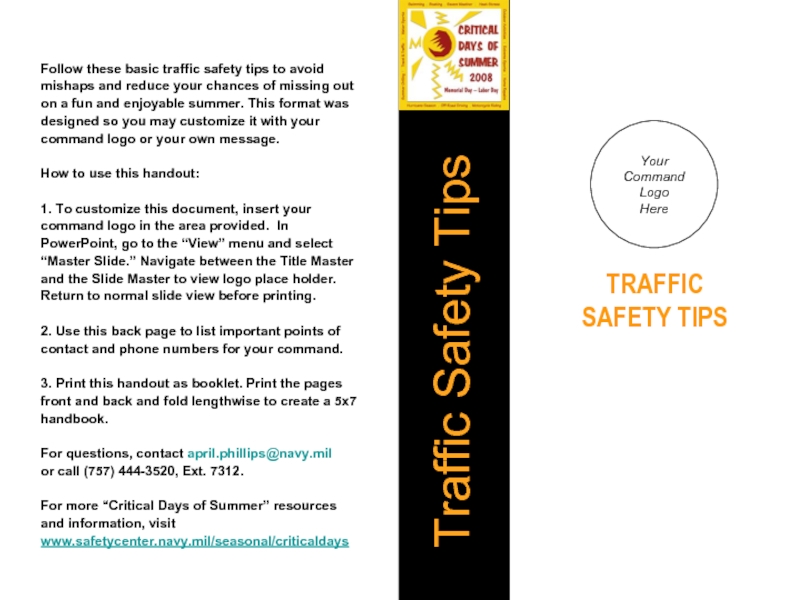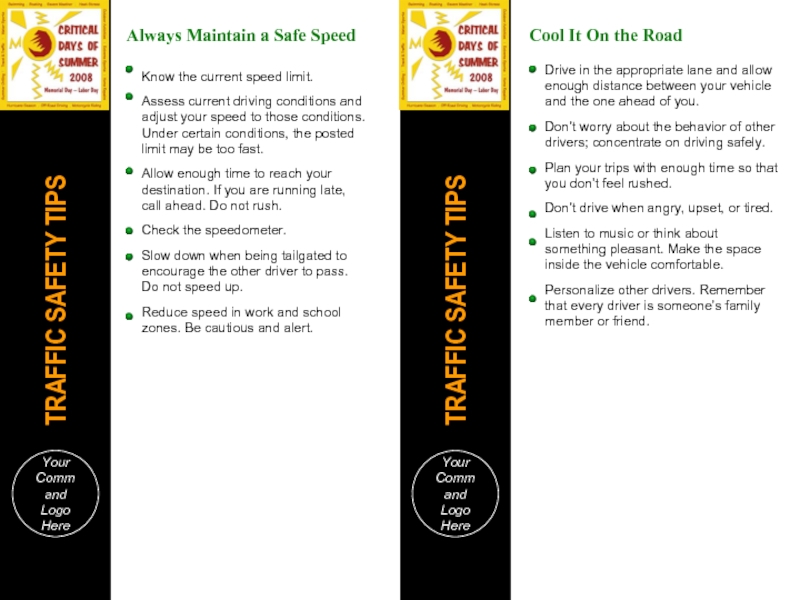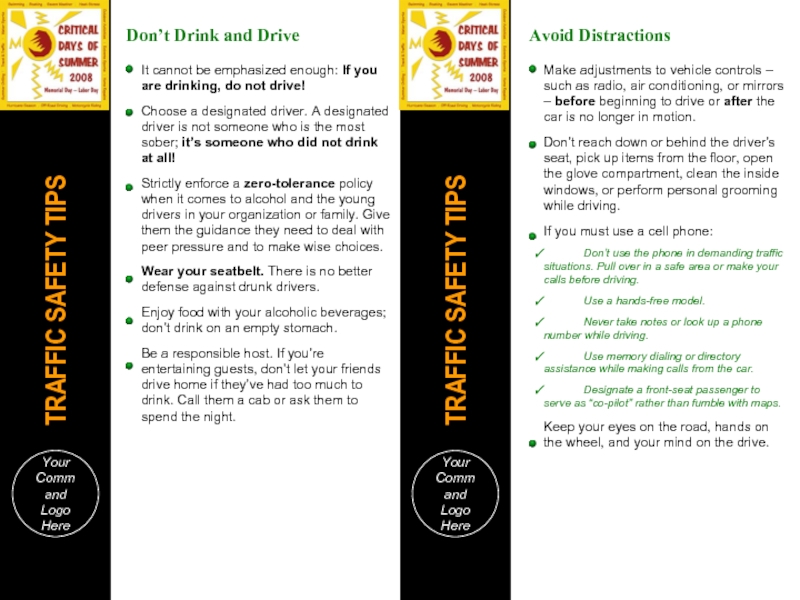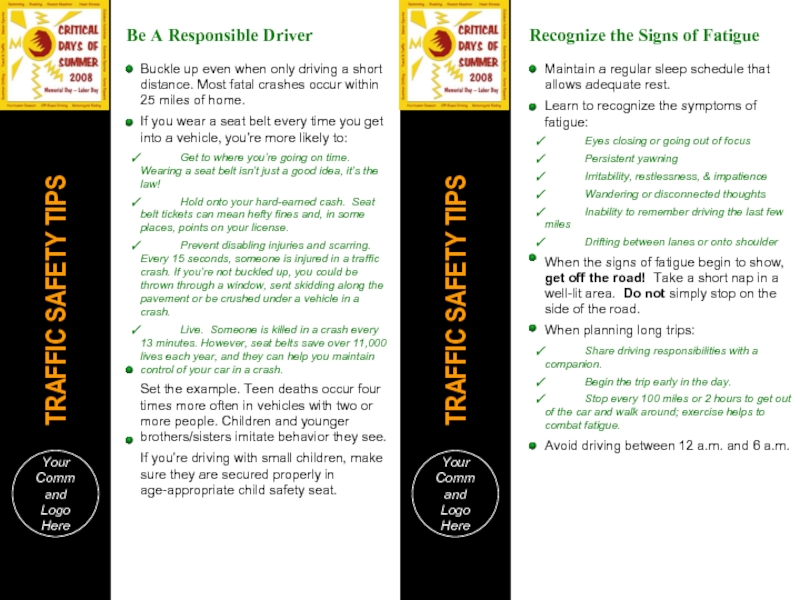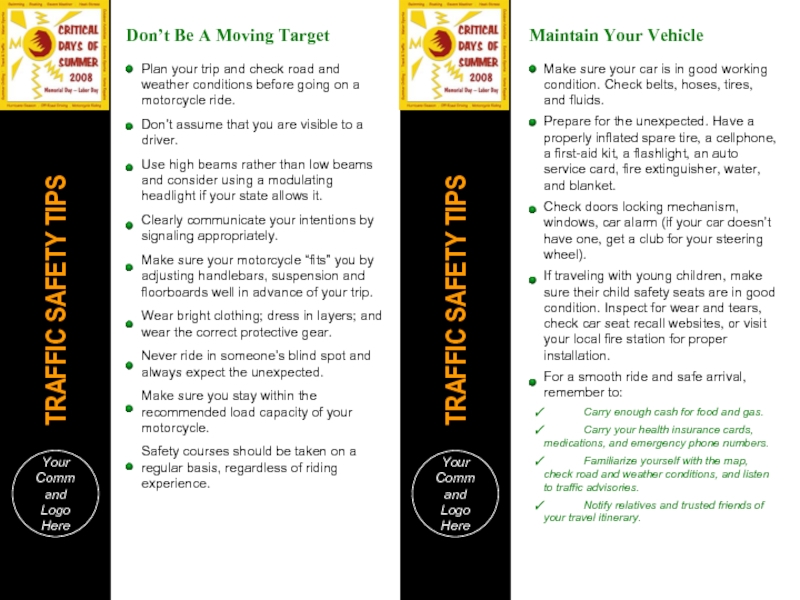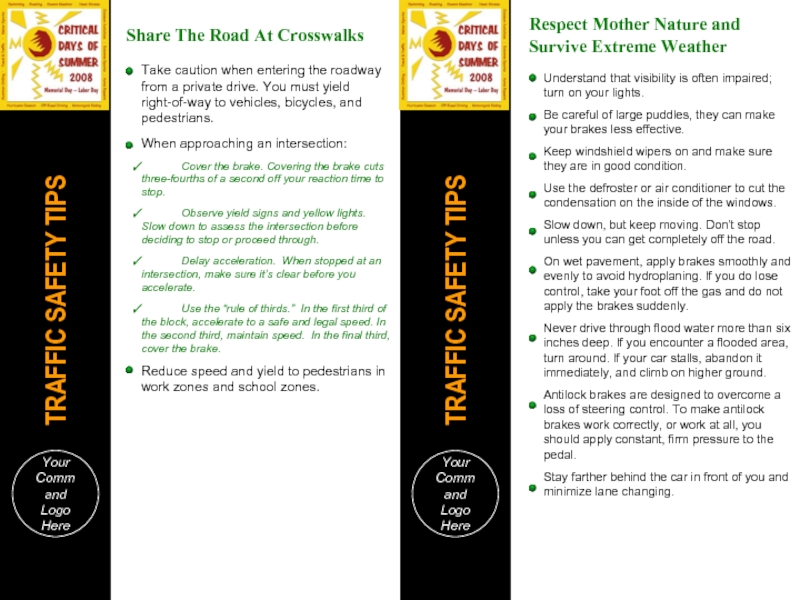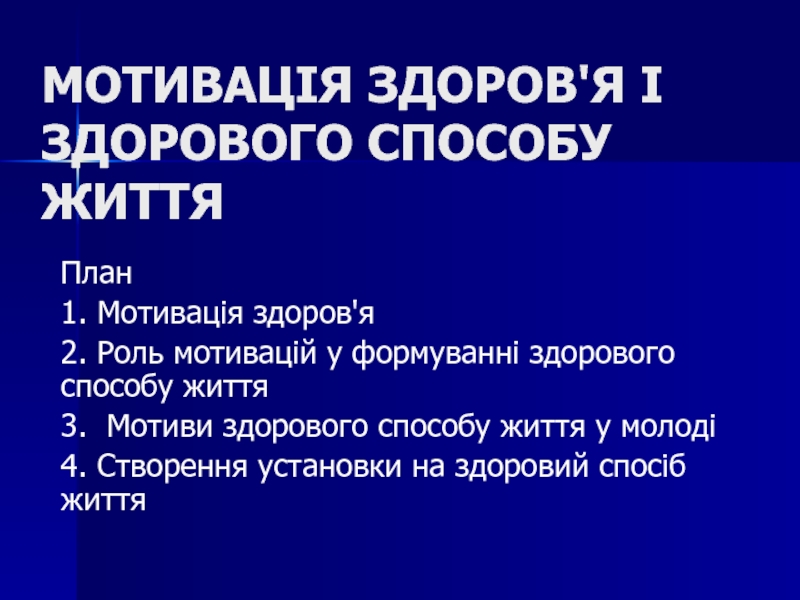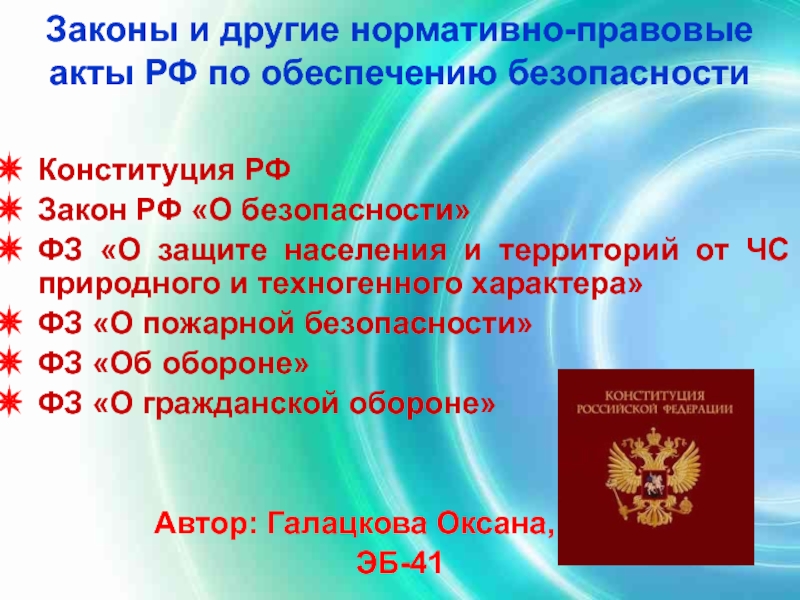- Главная
- Разное
- Дизайн
- Бизнес и предпринимательство
- Аналитика
- Образование
- Развлечения
- Красота и здоровье
- Финансы
- Государство
- Путешествия
- Спорт
- Недвижимость
- Армия
- Графика
- Культурология
- Еда и кулинария
- Лингвистика
- Английский язык
- Астрономия
- Алгебра
- Биология
- География
- Детские презентации
- Информатика
- История
- Литература
- Маркетинг
- Математика
- Медицина
- Менеджмент
- Музыка
- МХК
- Немецкий язык
- ОБЖ
- Обществознание
- Окружающий мир
- Педагогика
- Русский язык
- Технология
- Физика
- Философия
- Химия
- Шаблоны, картинки для презентаций
- Экология
- Экономика
- Юриспруденция
Traffic safety tips safety презентация
Содержание
Слайд 1Follow these basic traffic safety tips to avoid mishaps and reduce
Слайд 2Know the current speed limit.
Assess current driving conditions and adjust your
Allow enough time to reach your destination. If you are running late, call ahead. Do not rush.
Check the speedometer.
Slow down when being tailgated to encourage the other driver to pass. Do not speed up.
Reduce speed in work and school zones. Be cautious and alert.
Always Maintain a Safe Speed
Cool It On the Road
Drive in the appropriate lane and allow enough distance between your vehicle and the one ahead of you.
Don’t worry about the behavior of other drivers; concentrate on driving safely.
Plan your trips with enough time so that you don’t feel rushed.
Don’t drive when angry, upset, or tired.
Listen to music or think about something pleasant. Make the space inside the vehicle comfortable.
Personalize other drivers. Remember that every driver is someone’s family member or friend.
Слайд 3Don’t Drink and Drive
Avoid Distractions
It cannot be emphasized enough: If you
Choose a designated driver. A designated driver is not someone who is the most sober; it’s someone who did not drink at all!
Strictly enforce a zero-tolerance policy when it comes to alcohol and the young drivers in your organization or family. Give them the guidance they need to deal with peer pressure and to make wise choices.
Wear your seatbelt. There is no better defense against drunk drivers.
Enjoy food with your alcoholic beverages; don’t drink on an empty stomach.
Be a responsible host. If you’re entertaining guests, don’t let your friends drive home if they’ve had too much to drink. Call them a cab or ask them to spend the night.
Make adjustments to vehicle controls – such as radio, air conditioning, or mirrors – before beginning to drive or after the car is no longer in motion.
Don’t reach down or behind the driver’s seat, pick up items from the floor, open the glove compartment, clean the inside windows, or perform personal grooming while driving.
If you must use a cell phone:
Don’t use the phone in demanding traffic situations. Pull over in a safe area or make your calls before driving.
Use a hands-free model.
Never take notes or look up a phone number while driving.
Use memory dialing or directory assistance while making calls from the car.
Designate a front-seat passenger to serve as “co-pilot” rather than fumble with maps.
Keep your eyes on the road, hands on the wheel, and your mind on the drive.
Слайд 4Be A Responsible Driver
Recognize the Signs of Fatigue
Buckle up even when
If you wear a seat belt every time you get into a vehicle, you’re more likely to:
Get to where you’re going on time. Wearing a seat belt isn’t just a good idea, it’s the law!
Hold onto your hard-earned cash. Seat belt tickets can mean hefty fines and, in some places, points on your license.
Prevent disabling injuries and scarring. Every 15 seconds, someone is injured in a traffic crash. If you’re not buckled up, you could be thrown through a window, sent skidding along the pavement or be crushed under a vehicle in a crash.
Live. Someone is killed in a crash every 13 minutes. However, seat belts save over 11,000 lives each year, and they can help you maintain control of your car in a crash.
Set the example. Teen deaths occur four times more often in vehicles with two or more people. Children and younger brothers/sisters imitate behavior they see.
If you’re driving with small children, make sure they are secured properly in age-appropriate child safety seat.
Maintain a regular sleep schedule that allows adequate rest.
Learn to recognize the symptoms of fatigue:
Eyes closing or going out of focus
Persistent yawning
Irritability, restlessness, & impatience
Wandering or disconnected thoughts
Inability to remember driving the last few miles
Drifting between lanes or onto shoulder
When the signs of fatigue begin to show, get off the road! Take a short nap in a well-lit area. Do not simply stop on the side of the road.
When planning long trips:
Share driving responsibilities with a companion.
Begin the trip early in the day.
Stop every 100 miles or 2 hours to get out of the car and walk around; exercise helps to combat fatigue.
Avoid driving between 12 a.m. and 6 a.m.
Слайд 5Don’t Be A Moving Target
Maintain Your Vehicle
Plan your trip and
Don’t assume that you are visible to a driver.
Use high beams rather than low beams and consider using a modulating headlight if your state allows it.
Clearly communicate your intentions by signaling appropriately.
Make sure your motorcycle “fits” you by adjusting handlebars, suspension and floorboards well in advance of your trip.
Wear bright clothing; dress in layers; and wear the correct protective gear.
Never ride in someone’s blind spot and always expect the unexpected.
Make sure you stay within the recommended load capacity of your motorcycle.
Safety courses should be taken on a regular basis, regardless of riding experience.
Make sure your car is in good working condition. Check belts, hoses, tires, and fluids.
Prepare for the unexpected. Have a properly inflated spare tire, a cellphone, a first-aid kit, a flashlight, an auto service card, fire extinguisher, water, and blanket.
Check doors locking mechanism, windows, car alarm (if your car doesn’t have one, get a club for your steering wheel).
If traveling with young children, make sure their child safety seats are in good condition. Inspect for wear and tears, check car seat recall websites, or visit your local fire station for proper installation.
For a smooth ride and safe arrival, remember to:
Carry enough cash for food and gas.
Carry your health insurance cards, medications, and emergency phone numbers.
Familiarize yourself with the map, check road and weather conditions, and listen to traffic advisories.
Notify relatives and trusted friends of your travel itinerary.
Слайд 6Share The Road At Crosswalks
Respect Mother Nature and Survive Extreme Weather
Take
When approaching an intersection:
Cover the brake. Covering the brake cuts three-fourths of a second off your reaction time to stop.
Observe yield signs and yellow lights. Slow down to assess the intersection before deciding to stop or proceed through.
Delay acceleration. When stopped at an intersection, make sure it’s clear before you accelerate.
Use the “rule of thirds.” In the first third of the block, accelerate to a safe and legal speed. In the second third, maintain speed. In the final third, cover the brake.
Reduce speed and yield to pedestrians in work zones and school zones.
Understand that visibility is often impaired; turn on your lights.
Be careful of large puddles, they can make your brakes less effective.
Keep windshield wipers on and make sure they are in good condition.
Use the defroster or air conditioner to cut the condensation on the inside of the windows.
Slow down, but keep moving. Don’t stop unless you can get completely off the road.
On wet pavement, apply brakes smoothly and evenly to avoid hydroplaning. If you do lose control, take your foot off the gas and do not apply the brakes suddenly.
Never drive through flood water more than six inches deep. If you encounter a flooded area, turn around. If your car stalls, abandon it immediately, and climb on higher ground.
Antilock brakes are designed to overcome a loss of steering control. To make antilock brakes work correctly, or work at all, you should apply constant, firm pressure to the pedal.
Stay farther behind the car in front of you and minimize lane changing.
